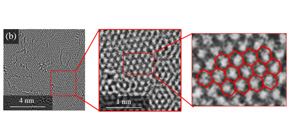
Successful observation of band transport with excellent electrical performance from defective graphene oxides
A step toward the scalable production of highly crystalline graphene thin films
Graphene is a single, one atom thick layer made of carbon atoms bonded in a honeycomb shape and has many appealing characteristics, such as excellent electric conductivity, mechanical strength, chemical stability, and a large surface area. For this reason, research on its synthesis and applications to electronic devices is being performed all over the world.
Graphene oxide (GO), which is produced through oxidation of graphite, has attracted a great deal of attention all over the world as a starting material in the synthesis of graphene. However, as GO has many defective structures, the carrier mobility of graphene films obtained after reduction treatment is a couple of cm 2 /Vs at most.
GO is hydrophilic, so it’s easy to disperse in water. It becomes possible to fabricate thin-film graphene with a thickness of 1–3 layers simply by dropping GO solution on a substrate, extracting water from it, and performing chemical reduction. Therefore, synthesis and reduction methods of GO are being studied all over the world as materials for synthesizing large amounts of graphene.
A group of researchers led by Assistant Professor NEGISHI Ryouta and Professor KOBAYASHI Yoshihiro at the Graduate School of Engineering, Osaka University, Associate Professor AKABORI Masashi at the Japan Advanced Institute of Science and Technology (JAIST), Associate Professor ITO Takahiro at the Graduate School of Engineering, Nagoya University, and Vice Director WATANABE Yoshio at the Aichi Synchrotron Radiation Center, succeeded in drastically increasing the crystallinity of GO by promoting the restoration of defective structures in thermal reduction treatment at a high temperature of up to 1100 ºC in which a small amount of ethanol gas was added in the reduction process. This group also succeeded in observing a band transport reflecting intrinsic graphene electrical transport properties in chemically reduced GO thin films, a world first. This band transport achieved a carrier mobility of (~210cm 2 /Vs), the highest level of chemically reduced GO films.
This group’s achievement has enabled the fabrication of graphene thin films through reduction treatment. It is expected that this technique will be used in various applications such as electronic devices and sensors using graphene.
Abstract
The electrical transport property of the reduced graphene oxide (rGO) thin-films synthesized from defective GO through thermal treatment in a reactive ethanol environment at high temperature above 1000°C shows a band-like transport with small thermal activation energy (E a ~10 meV) that occurs during high carrier mobility (~210 cm 2 /Vs). Electrical and structural analysis using X-ray absorption fine structure, the valence band photo-electron, and Raman spectra indicate that a high temperature process above 1000°C in the ethanol environment leads to an extraordinary expansion of the conjugated p-electron system in rGO due to the efficient restoration of the graphitic structure. We reveal that E a decreases with the increasing density of states near the Fermi level due to the expansion of the conjugated p-electron system in the rGO. This means that E a corresponds to the energy gap between the top of the valence band and the bottom of the conduction band. The origin of the band-like transport can be explained by the carriers, which are more easily excited into the conduction band due to the decreasing energy gap with the expansion of the conjugated p-electron system in the rGO.




To learn more about this research, please view the full research report entitled “ Band-like transport in highly crystalline graphene films from defective graphene oxides ” at this page of the Journal of Neuroscience website.
Related link
